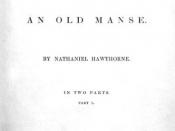The End of Innocence The philosopher Hooper once stated, ?Innocence is a flower, which withers when touched, but blooms not again, though watered with tears?(Mackey). Once innocence is lost to sin, there is no way to recover it. Nathaniel Hawthorne?s character, Young Goodman Brown, is one such example. After making a journey down the dark path of evil, Goodman Brown?s innocence and beliefs are lost forever. Throughout the short story ?Young Goodman Brown,? Hawthorne uses imagery and symbolism to amplify the theme of innocence lost.
From the beginning of the story, Goodman Brown?s wife, Faith, is used as a symbol of religion, or his own Christian faith. He sees her as a ?blessed angel,? claiming that he will ?cling to her skirts and follow her to heaven?(Hawthorne 268). The pink ribbons in her hat reveal innocence, both in Faith and in Goodman Brown. When he meets his traveling companion in the woods, Goodman Brown claims, ?Faith kept me back a while?(Hawthorne 268).
This statement has a double meaning. Although his wife did physically keep Goodman Brown back, it was really his own Christian beliefs that delayed the journey into the woods. As he journeys deeper into the woods, Goodman Brown hears Faith?s voice and a scream, followed by the appearance of one of her pink hair ribbons. The lost ribbon symbolizes the innocence that Goodman Brown is losing by traveling the path of sin. Grasping the ribbon, Young Brown cries, ?My Faith is gone! There is no good on earth...come, devil, for to thee is this world given?(Hawthorne 272). His wife taken by the village, Goodman Brown gives up on his own beliefs as well.
Young Goodman Brown continues on to the witches? coven with a vengeance, and there he finds a ?loathful brotherhood? with the congregation.


